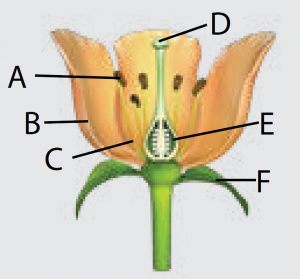Question 1:
The diagram below shows the structure of a flower.
Answer:
(a)
A : anther
B : petal
C : filament
D : stigma
E : ovary
F : sepal
The diagram below shows the structure of a flower.

(a) Label parts A – F.
(b) State the function of parts A – F.
Answer:
(a)
A : anther
B : petal
C : filament
D : stigma
E : ovary
F : sepal
(b)
A : Has pollen sacs which contain pollen grains (microspores)
B : Attracts insects and animals
C : Stalk that holds up the anther
D : Place where pollination occurs
E : Female reproductive organ
F : Protects the flower at bud stage
Question 2:
Why are stamens and carpels known as the reproductive organs of flowering plants?
Why are stamens and carpels known as the reproductive organs of flowering plants?
Answer:
Anther produces male gametes (pollen grains) while carpel produces embryo sac.
Question 3:
Compare male and female reproductive organs of flowers in terms of their:
(a) Names
(b) Structures that form them
(c) Functions
Compare male and female reproductive organs of flowers in terms of their:
(a) Names
(b) Structures that form them
(c) Functions
Answer:
